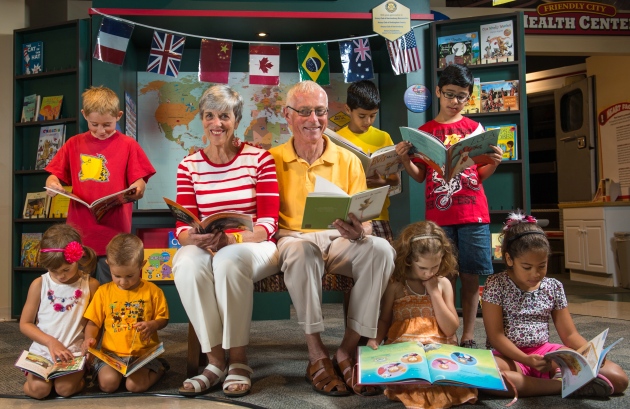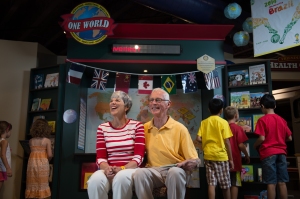Reading the world
August 28, 2014 4 Comments
It’s very early on a summer morning. Harrisonburg’s Explore More Discovery Museum is quiet, empty. The doors are locked for the moment. Soon, though, a handful of children trickle in with their parents or grandparents. Some are wide-awake, raring to go. Others are sleepy-eyed and hang back. They’ve all gathered for a photo shoot for Madison magazine, along with Dr. and Mrs. Fred Fox. They’ve come to illustrate what’s most important about the museum’s “One World” exhibition. The shoot could be chaos, but it goes smoothly. Perhaps it’s good parenting. Or maybe it’s the books. Or both. Either way, we get it done so we can tell a story that’s important for children in the valley, for families, for the community — and for discovering a wonderful way to get to know ourselves and our neighbors……
 A passion for reading the world
A passion for reading the world
Gail and Fred Fox are passionate about literacy, diversity — and their community. That’s why they’ve championed One World, a popular exhibit in Harrisonburg’s children’s museum. The collection features children’s books, many in their native languages, from more than 42 countries around the world. (The number just went up!)
The creation of the exhibit was a bit serendipitous. In 2010, Explore More Discovery Museum was expanding, and the Foxes were asked to help. When Executive Director Lisa Shull (’81,’95M) posed the question, “What kind of exhibits to you want?” the couple suggested one where literacy and diversity would converge.
Gail, who formerly taught reading and literacy at JMU and worked as a reading coach in Harrisonburg City Public Schools for “No Child Left Behind,” and her husband Fred, a local orthopaedic surgeon, proposed an exhibit where Harrisonburg’s rich cultural diversity could be showcased through books.
And then they championed it.
“We’d been in other [children’s] museums where they had reading corners or diversity represented by pictures of children or something, but we felt [it was] very important to have this sort of concept in the museum,” Fred says.
Harrisonburg city schools, one of Virginia’s most diverse school systems, enrolls students from 40 countries, representing 44 foreign languages. More than 100 students are bi-or multi-lingual.
 The idea for the exhibit had been percolating with the Foxes for some time. Earlier, through the Harrisonburg Rotary Club, Fred and Gail, along with a librarian at Waterman Elementary School in Harrisonburg, had started a literacy program through the local schools. “It was just an interesting blend of Gail’s background in early childhood literacy and my experience with Rotary,” Fred says. “Out of those two interests we had formed … Project Read, focusing on elementary, helping support children to learn reading in K-3 and in the preschool reading program, which all the [local] Rotary Clubs in some form participated in,” he says.
The idea for the exhibit had been percolating with the Foxes for some time. Earlier, through the Harrisonburg Rotary Club, Fred and Gail, along with a librarian at Waterman Elementary School in Harrisonburg, had started a literacy program through the local schools. “It was just an interesting blend of Gail’s background in early childhood literacy and my experience with Rotary,” Fred says. “Out of those two interests we had formed … Project Read, focusing on elementary, helping support children to learn reading in K-3 and in the preschool reading program, which all the [local] Rotary Clubs in some form participated in,” he says.
A longtime Rotarian himself, Fred notes that literacy has long been a focus of Rotary International, so when the opportunity at the museum arose, once again, the fit was right. Many local Rotary Club members donated books they found abroad and brought back to Harrisonburg.
Because of Harrisonburg’s diverse population, the exhibit also presents enormous opportunities for international understanding, which Gail knows is essential for student success in the city’s schools. “It’s the United Nations in every school here,” she says.
The One World book collection’s location within the museum was strategic, the Foxes believe. It brings literacy and diversity into a place where children are automatically drawn. Its international character, Gail explains, “says to children, ‘you have a place here. Your culture is part of what is going on downtown at Explore More.”
Gail adds that children who might not otherwise have access to books can be exposed to them at the museum. “They have them right here in a safe environment where they can come.”
Immigrant families, she adds, are more likely to visit the museum before they visit the public library. And with Massanutten Regional Library located next door, it becomes an entre to the library next door. The placement also aligns with the museum’s longstanding mission to serve all community children.
Fred cites a local family whose child, adopted from Ethiopia, discovered a book in One World from his home country. “It was sort of a ‘wow’ moment,” he says.
Although electronic books and online sourcing is growing, there’s no substitute for a hands-on book when it comes to children, Gail believes. And she is an unapologetic advocate for traditional books.
“Through books you find the language,” she says, “you find how stories work, whether they’re oral or written…. There is such an intimacy between the reader and the child that you can’t get through flicking through a story on an Ipad.”
For a child from a different culture — or any child, for that matter — the experience of sharing a book is potent. Gail says, effusively: “Do you know how powerful it is when you’re reading a book to a child and [the child says] ‘Oh, that person looks like me!’”
The exhibit’s shelves have been filled with the help of several community organizations, including Blue Ridge Community College’s SPECTRUM International Multicultural Club. The group donated more than 40 bilingual books to One World. According to their website: “The purpose of purchasing these books is two-fold; it provides newly immigrated families the ability to read in their native language as well as learning the English language. It also provides SPECTRUM members the opportunity to share their heritage with the community.”
Books have also come from Rockingham Memorial Hospital’s Wellness Center, United Way, and Knitworks, a local business. Several were even sent by a AAA tourist group from Chicago after they visited Harrisonburg.
Impassioned advocates, the Foxes regularly encourage friends to bring books back from their international travels — including Gail’s fellow JMU alumni — to help grow the One World book collection. They hope it will encourage literacy and promote deeper cultural understanding throughout the community — and they believe it will, Gail says, “because children lead the way.”
Many thanks to Fred and Gail Fox, Daphyne Thomas (COB), Cristin Lambert Iwanicki (’03), Grace Tessier Weniger (’03), Sonali Aradhey, and university photographer Mike Miriello (’09) — and especially to Maya, Noah, Anish, Niranjan, Bree, Amaya and Connor for making our very early morning photo shoot a success!







Recent Comments